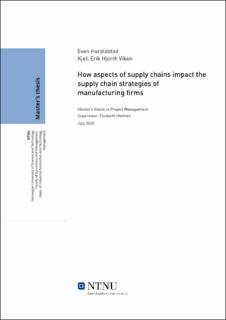| dc.description.abstract | Formålet med denne oppgaven er å undersøke hvordan forsyningskjedeaspekter kan påvirke valget av forsyningskjedestrategi. Forå oppnå dette er forsyningskjedeaspektene produkt- og markedskarakteristikker, avkoblingspunkt (decoupling point), plassering av lager, transport og ”bullwhip-effekt” undersøkt i forhold til forsyningskjeden for et produkt fra perspektivet til et hovedfirma i Skandinavia. For å vurdere oppstrøms operasjoner fra hovedfirmaet er to komponenter som leveres fra to forskjellige leverandører inkludert. Relasjonene til disse leverandørene er også analysert med hensyn til deres påvirkning på forsyningskjedestrategien.
Før forsyningskjedeaspektene er analysert i en reell case, gjennomføres en narrativ litteraturstudie. I denne studien presenteres forslagene fra litteraturen i forhold til hvordan forsyningskjedeaspektene påvirker valget av forsyningskjedestrategi. For å undersøke om forslagene fra litteraturen også gjelder i praksis, gjennomføres en casestudie der analyseenheten er forsyningskjeden til et produkt. I denne casestudien blir data samlet inn gjennom to møter og to intervjuer med hovedfirmaet i forsyningskjeden. I tillegg brukes dokumenter levert av hovedfirmaet og komplementær data fra Internett for å samle inn data. Basert på disse datakildene blir funnene fra casestudien presentert, der den nåværende forsyningskjeden for produktet er beskrevet.
Hovedfunnet i hovedfirmaets nåværende forsyningskjedestrategi er at de legger vekt på høy effektivitet (efficiency) og lover kundene korte leveringstider. Dette medfører høye lagernivåer og overproduksjon for hovedfirmaet. Et annet funn er at når man ser på relasjonene til leverandørene er deres produksjonsmetoder og forsyningskjedestrategier ikke i samsvar med hovedfirmaet. Basert på dette foreslås fire forsyningskjedestrategier for hovedfirmaet, inkludert en foretrukket forsyningskjedestrategi for leverandørene i samsvar med hovedfirmaets strategi. De fire foreslåtte strategiene er lean (mager), agile (smidig), hybrid og dual (dobbel) forsyningskjedestrategi. Disse legger vekt på høy effekt (effectiveness), og bør forbedre den nåværende forsyningskjedestrategien til hovedfirmaet og leverandørene. Dessuten, noen av de fire forelåtte strategiene krever at leverandørene skal levere med korte leveringstider for at strategien kan være gjennomførbar. Dermed, er det blitt gjennomført en analyse av kunde – levereandør forholdet. I denne analysen ser det ut til at det vil være mer mulig for hovedfirmaet å påvirke en av leverandørene å endre sin forsyningskjedestrategi, på grunn av høy gjensidig avhengighet i forholdet. | |
| dc.description.abstract | The purpose of this thesis is to examine how supply chain aspects can impact the choice of supply chain strategy. To achieve this, the supply chain aspects of product and market characteristics, decoupling point, location of inventory, transportation, and bullwhip effect are examined in relation to the supply chain for a product with the perspective of a lead firm in Scandinavia. To assess the upstream operations from the lead firm, two components that are supplied from two different suppliers are included. The relationships with these suppliers are also analyzed regarding their impact on the supply chain strategy.
Before the supply chain aspects are analyzed in a case, a narrative literature review was conducted. In this review, the suggestions from the literature are presented in terms of how the supply chain aspects impact the choice of supply chain strategy. To examine if the suggestions from the literature also apply in practice, a case study was conducted where the unit of analysis is the supply chain for a product. In this case study, data was collected through two meetings and two interviews with the lead firm in the supply chain. Also, documents provided by the lead firm and complementary data from the Internet were used to collect data. Based on these sources of data, the findings from the case study are presented, where the current supply chain of the product is described.
The main finding on the lead firm’s current supply chain strategy is that they are emphasizing high efficiency and promising customers’ short delivery lead time. This causes high inventory levels and overproduction for the lead firm. Another finding is that when looking at the relationships with the suppliers, their production methods and supply chain strategies do not align with the lead firm. Based on this, four supply chain strategies are proposed for the lead firm, including a preferred supply chain strategy for the suppliers following the lead firm’s strategy. The four suggested strategies are the lean, agile, hybrid, and dual supply chain strategy. These are emphasizing high effectiveness and should improve the current supply chain strategy of the lead firm and the suppliers. Furthermore, some of the four suggested strategies require the suppliers to deliver with short supply lead times for the strategy to be feasible. Thus, an analysis of the customer – supplier relationships is also conducted. In this analysis, it appears that it would be more possible for the lead firm to influence one of the suppliers to change their supply chain strategy due to high interdependency in the relationship. | |
